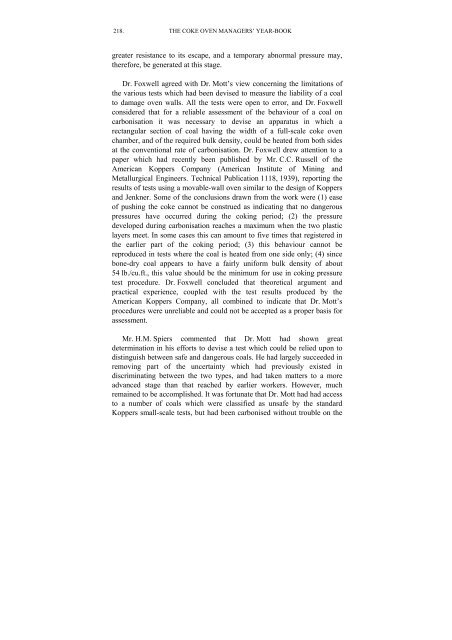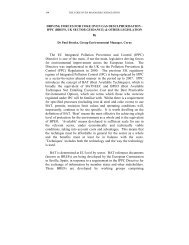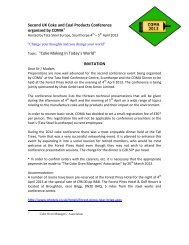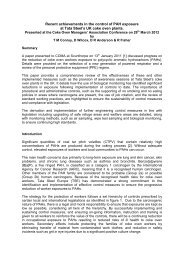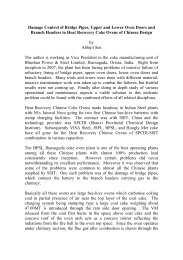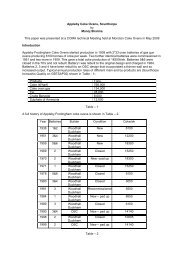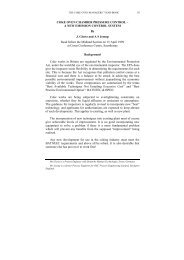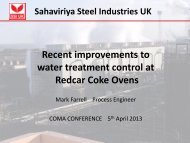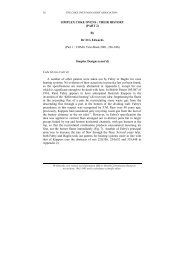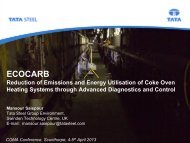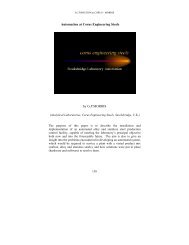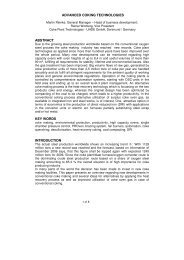CHAIRMAN'S ADDRESS - Coke Oven Managers Association
CHAIRMAN'S ADDRESS - Coke Oven Managers Association
CHAIRMAN'S ADDRESS - Coke Oven Managers Association
- No tags were found...
You also want an ePaper? Increase the reach of your titles
YUMPU automatically turns print PDFs into web optimized ePapers that Google loves.
218. THE COKE OVEN MANAGERS’ YEAR-BOOKgreater resistance to its escape, and a temporary abnormal pressure may,therefore, be generated at this stage.Dr. Foxwell agreed with Dr. Mott’s view concerning the limitations ofthe various tests which had been devised to measure the liability of a coalto damage oven walls. All the tests were open to error, and Dr. Foxwellconsidered that for a reliable assessment of the behaviour of a coal oncarbonisation it was necessary to devise an apparatus in which arectangular section of coal having the width of a full-scale coke ovenchamber, and of the required bulk density, could be heated from both sidesat the conventional rate of carbonisation. Dr. Foxwell drew attention to apaper which had recently been published by Mr. C.C. Russell of theAmerican Koppers Company (American Institute of Mining andMetallurgical Engineers. Technical Publication 1118, 1939), reporting theresults of tests using a movable-wall oven similar to the design of Koppersand Jenkner. Some of the conclusions drawn from the work were (1) easeof pushing the coke cannot be construed as indicating that no dangerouspressures have occurred during the coking period; (2) the pressuredeveloped during carbonisation reaches a maximum when the two plasticlayers meet. In some cases this can amount to five times that registered inthe earlier part of the coking period; (3) this behaviour cannot bereproduced in tests where the coal is heated from one side only; (4) sincebone-dry coal appears to have a fairly uniform bulk density of about54 lb./cu.ft., this value should be the minimum for use in coking pressuretest procedure. Dr. Foxwell concluded that theoretical argument andpractical experience, coupled with the test results produced by theAmerican Koppers Company, all combined to indicate that Dr. Mott’sprocedures were unreliable and could not be accepted as a proper basis forassessment.Mr. H.M. Spiers commented that Dr. Mott had shown greatdetermination in his efforts to devise a test which could be relied upon todistinguish between safe and dangerous coals. He had largely succeeded inremoving part of the uncertainty which had previously existed indiscriminating between the two types, and had taken matters to a moreadvanced stage than that reached by earlier workers. However, muchremained to be accomplished. It was fortunate that Dr. Mott had had accessto a number of coals which were classified as unsafe by the standardKoppers small-scale tests, but had been carbonised without trouble on the


